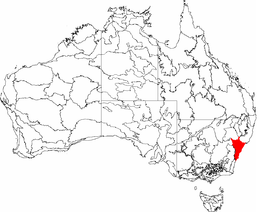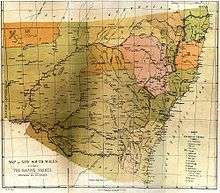Kuringgai
Kuringgai (also spelled Ku-ring-gai, Kuring-gai, Guringai, Kuriggai) (IPA: [kuriŋɡai],[1]) is an ethnonym referring to (a) an hypothesis regarding an aggregation of Indigenous Australian peoples occupying the territory between the southern borders of the Gamilaraay and the area around Sydney (b) perhaps an historical people with its own distinctive language, located in part of that territory, or (c) people of Aboriginal origin who identify themselves as descending from the original peoples denoted by (a) or (b) and who call themselves Guringai.
| Kuringgai people | |
|---|---|
| aka: Ku-ring-gai, Kuring-gai, and Guringai Kuringgai (AIATSIS), nd (SIL) | |
 Sydney Basin bioregion | |
| Hierarchy | |
| Language family: | Pama–Nyungan |
| Language branch: | Yuin–Kuric |
| Language group: | unknown |
| Group dialects: | unknown |
| Area | |
| Bioregion: | Sydney Basin |
| Location: | Sydney, Central Coast, and Newcastle, New South Wales |
Origins of the ethnonym
In 1892, ethnologist John Fraser edited and republished the work of Lancelot Edward Threlkeld on the language of the Awabakal people, An Australian Grammar, with lengthy additions. In his "Map of New South Wales as occupied by the native tribes" and text accompanying it, he deploys the term Kuringgai to refer to the people inhabiting a large stretch of the central coastline of New South Wales. He regarded the language described by Threlkeld as a dialect of a larger language, variations of which were spoken by many other tribes in New South Wales, and, in order to define this perceived language block he coined the word Kurriggai/Kuringgai:
we have now come to know that this dialect was essentially the same as that spoken by the sub-tribes occupying the land where Sydney now stands, and that they all formed parts of one great tribe, the Kuriggai.[2]
Fraser lists a number of tribes to the north of his assumed Kuriggai language family: the Gamilaraay and their sub-tribes, the Ualarai and Weilwan. In the text accompanying his map, he states:
The next great tribe is the Kuringgai on the sea coast. Their taurai (hunting ground or territory) is known to extend north to the Macleay River, and I found that southwards it reached the Hawkesbury. then after, by examining the remains of the language of the natives about Sydney and southwards, and by other tests, I assured myself that the country thereabout was occupied by sub-tribes of the Kurringgai.[3]

Norman Tindale, in his 1974 classic survey of all known Australian tribes, was dismissive of Fraser's conjecture as "poor" in details, and "unquestionably the most inaccurate and garbled account ever published about the aborigines. Many of his tribal names were pure artifacts", each created to subsume under an invented label several different tribal identities: thus his fantasy of a Paikalyung crushed together 10 tribal units; his Yunggai nation throws together the Anēwan, Jukambal and the Kwiambal; his Wachigaru dissolves into one fictional unity the Banbai, Gumbaynggirr, Ngaku and some of the Dunghutti. Even his acknowledgement of the Ualarai actually sweeps up 5 distinct aboriginal societies.[4] Under his heading for the Awabakal, he writes:
the Awabakal are the central one of a series of tribes to which the arbitrary term Kuringgai has been applied by Fraser.
Where Fraser discerned one "nation", Tindale defined a conglomeration of distinct tribes such as the Tharawal, Eora, Dharuk, Darkinjang, Awabakal, Worimi, Wonnarua, Birpai and Ngamba.[5]
Arthur Capell, writing four years earlier, thought to the contrary that Kuringgai/Guriŋgai denoted some substantive historical reality, and was an appropriate name for the language spoken on the north side of Port Jackson northwards at least as far as Tuggerah Lakes.[6] He concluded under the heading Karee/Kuringgai' that the reference is to:-
the language of the Pittwater people, and included the well-known Cammeraygal on the extreme south, along the northern shores of Port Jackson, and stretched as far north at least as Broken Bay. This is the basis for the statement above that the "Sydney" language did not cross Port Jackson[7][8]
Val Attenbrow dismissed Capell's claim for an independent Guriŋgai, while Amanda Lissarrague and Jim Wafer reanalyzed the material and concluded the word denoted the "Hunter River-Lake Macquarie language", otherwise known as Awabakal.[9]
Notable people
- Bungaree, a Broken Bay clan member who was selected by Governor Lachlan Macquarie to be "king" of the Sydney "blacks".[10]
Today
The name invented by John Fraser still reverberates in a number of placenames and institutions in New South Wales.
- Electoral district of Ku-ring-gai
- Hornsby Ku-ring-gai Hospital
- Ku-ring-gai Chase National Park
- Ku-ring-gai High School
- Ku-ring-gai Council
- Mount Ku-ring-gai
- Kuring-gai College of Advanced Education, subsumed in 1989 as part of the University of Technology, Sydney
Notes
Citations
- Steele 2005.
- Threlkeld & Fraser 1892, p. v.
- Threlkeld & Fraser 1892, p. ix.
- Tindale 1974, pp. 127–128.
- Tindale 1974, pp. 191–202.
- Capell 1970, p. 21.
- Capell 1970, p. 24.
- Steele 2005, p. 12.
- AIATSIS.
- Foley 2007, pp. 181–182.
Sources
- Attenbrow, Val (2010). Sydney's Aboriginal Past: Investigating the Archaeological and Historical Records. University of New South Wales Press. ISBN 978-1-742-23116-7.
- Capell, A. (September 1970). "Aboriginal Languages in the South Central Coast, New South Wales: Fresh Discoveries". Oceania. 41 (1): 20–27. JSTOR 40329895.
- Foley, Dennis (2007). "Leadership: the quandary of Aboriginal societies in crises, 1788 – 1830, and 1966". In Macfarlane, Ingereth; Hannah, Mark (eds.). Transgressions: Critical Australian Indigenous histories. Australian National University Press. pp. 177–192. ISBN 978-1-921-31344-8. JSTOR j.ctt24hfb0.12.
- "Ku-ring-gai". AIATSIS. Archived from the original on 27 August 2016. Retrieved 1 January 2013.
- Maynard, John (2014). True Light and Shade: An Aboriginal Perspective of Joseph Lycett's Art. National Library of Australia. ISBN 978-0-642-27708-4.
- Ridley, William (1861). Lang, Gideon S. (ed.). The Aborigines of Australia (PDF). London: Edward Stanford.
- Steele, Jeremy M. (December 2005). The aboriginal language of Sydney (PDF) (M.A. thesis). Macquarie University. Retrieved 1 January 2013.
- Threlkeld, L.E.; Fraser, John (1892). An Australian language as spoken by the Awabakal, the people of Awaba, or lake Macquarie (near Newcastle, New South Wales) being an account of their language, traditions, and customs (PDF). Sydney: C. Potter, Govt. Printer.
- Tindale, Norman Barnett (1974). "Awabakal (NSW)". Aboriginal Tribes of Australia: Their Terrain, Environmental Controls, Distribution, Limits, and Proper Names. Australian National University.
Further reading
- Fraser, John. The Aborigines of New South Wales (PDF). University of Newcastle.